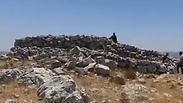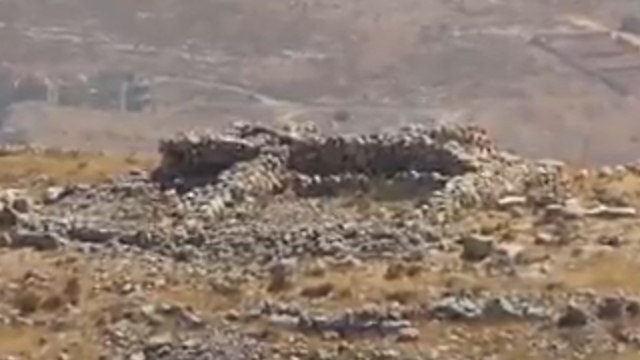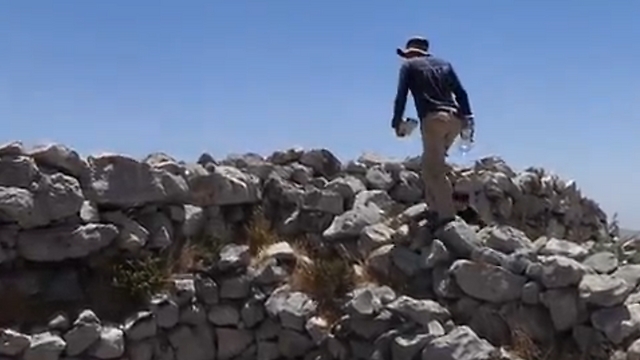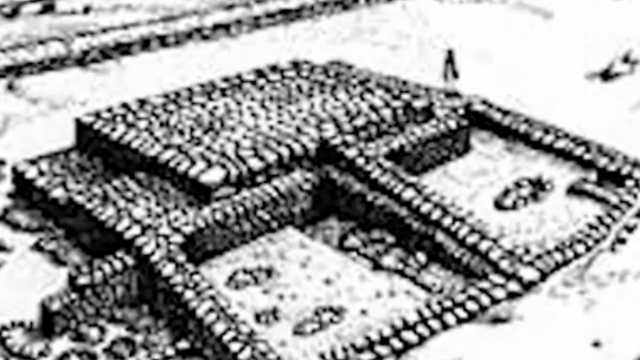

A rare visit to the supposed altar of prophet Joshua
Visiting the archeological site known as 'Joshua's Altar' is difficult, as it's in Area B near Nablus in the West Bank. The site itself is large and impressive, and it's location is extraordinary. Clay fragments from the area were found to fit ancient Jewish settlement periods in the area.
He was able to date the site to the end of the 13th century BCE, and found it to be an unusual ritual site whose dimensions correspond directly with the biblical Altar of Joshua.
Visiting the site is complicated and sometimes even dangerous. The mountain is situated in the West Bank's Area B, where the Palestinian Authority has control over administrative affairs and the IDF has responsibility over security matters. Getting to the site requires security cooperation with the IDF so that they can open and clear the route and ensure the security of the travelers.
Yair Almakais, head of the Shomron Tourism and Teaching Center, is one of the only guides who gives tours of the site. We go early in the morning, embarking from the town of Shevi Shomron in an a civilian all terrain vehicle, and go into a convoy between two armored IDF vehicles filled with soldiers from the Nahal Reconnaissance Battalion in full battle gear.
The site is considered a closed military zone and is completely devoid of people – neither Israeli nor Palestinian. The mountain has therefore been unintentionally turned into a nature reserve for the local flora and fauna. We see deer and fat rock hyrax on the road.
The gravel road ends close to the site, and we get out of the cars. We walk with the soldiers towards the giant rectangular ruins at the top of the hill. Almakais opens up a bible and reads the lines which Professor Zertal claimed describe the archaeological site at whose foot we stand.
"And when you have crossed the Jordan, set up these stones on Mount Ebal, as I command you today, and coat them with plaster.Build there an altar to the Lord your God, an altar of stones. Do not use any iron tool on them." – Deuteronomy 27.
"Then Joshua built on Mount Ebal an altar to the Lord, the God of Israel, as Moses the servant of the Lord had commanded the Israelites. He built it according to what is written in the Book of the Law of Moses—an altar of uncut stones, on which no iron tool had been used. On it they offered to the Lord burnt offerings and sacrificed fellowship offerings." – Joshua 8.
The site itself is big and impressive – in an unusual spot and at a single layer. Potsherds from the time period of the first Jewish settlements from Prophet Joshua's time litter the ground.
A Unique ritual site
Dr. Zartal died a year before the final scientific paper on the site was published. Archaeologist Dr. Shay Bar, research fellow at the University of Haifa, supports his hypothesis that this is the altar.
"Professor Zartal's archeological digs discovered either a unique ritual site new settlers who came into the Jordan Valley and east Shomron in the early Iron Age. The Scarabs found at the site chronologically categorize (this site to be from) the estimated time of the exodus and the conquering of the land by (the biblical Joshua). If we look for historical sources for that period, the bible mentions the spot explicitly. But even a logical assumption isn't scientific proof.”
Rabbi Yoel Ben Nun, one of the founders of Yeshivat Har Etzion, wrote a hlalkhic article in which he found several signs that point to this alter being built according to Jewish law: The foundation not surrounding all sides, a double space for the altar and foundation, the space between the foundation and altar, two fire pits, and more.
"The discovery of the site by Prof. Zartal was a (big) surprise. It didn't fit what we thought (before). We were used to thinking of (the biblical Joshua's) stand being in the Nablus area – between Mount Gerizim and Mount Ebal. Suddenly I come to a place from which you can't see the city of Nablus and it's facing Mount Kabir and not Mount Grizim (according to the Samaritan identification). I went through the bible verses in which Mount Ebal is mentioned and discovered that the city of Nablus isn't mentioned in connection to it at all. We had an incorrect theory about identifying the spot. I told (Prof. Zartal) – you have convinced me!"
Other researchers oppose the theory, finding contradictions in it, such as the rectangular structure of the site compared with the square structure of other altars discovered in Israel, the site's being dated to 150 years after Joshua's time, and of course – the scientific approach to researching the biblical text, which was written hundreds of years after the alleged occurrences.
Dr. Yitzhaki Paz, a senior archaeologist at the Israel Antiquities Authorities has another interpretation for the findings on Mt. Ebal.
"There is a hypothesis that these ruins are the ruins of the base of a guard tower. In any case, archeology isn't an exact science, and there is no way to prove the connection between this archaeological site and Yehoshua Ben Nun from the bible 100 percent."
The Shomron Tourism and Teaching Center and the Shomron Tourism Office have organized trips to the site during the middle days of Sukkot and Passover.
Shomron Regional Council head Yossi Dagan explains the importance of people coming to visit the site. "There are a lot of different places in the Shomron which are deeply rooted in Jewish history. One of them is the alter of Yehoshua Ben Nun. We have also found the pit where Joseph was thrown into in the Dotan Valley, ancient Shchem, and more. The Shomron Regional Council and the Shomron Tourism Council place high importance on bringing visitors from all over the country and the world and from all walks of life to these extraordinary places. Interest in these places and having people come to these places seem to be a victory in the public relations battle both in Israel and the world."



















